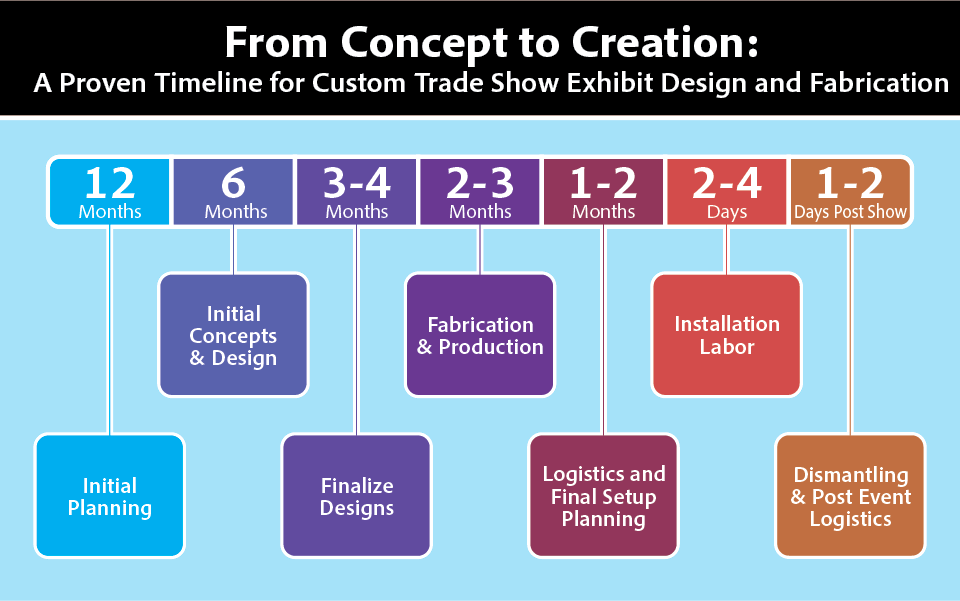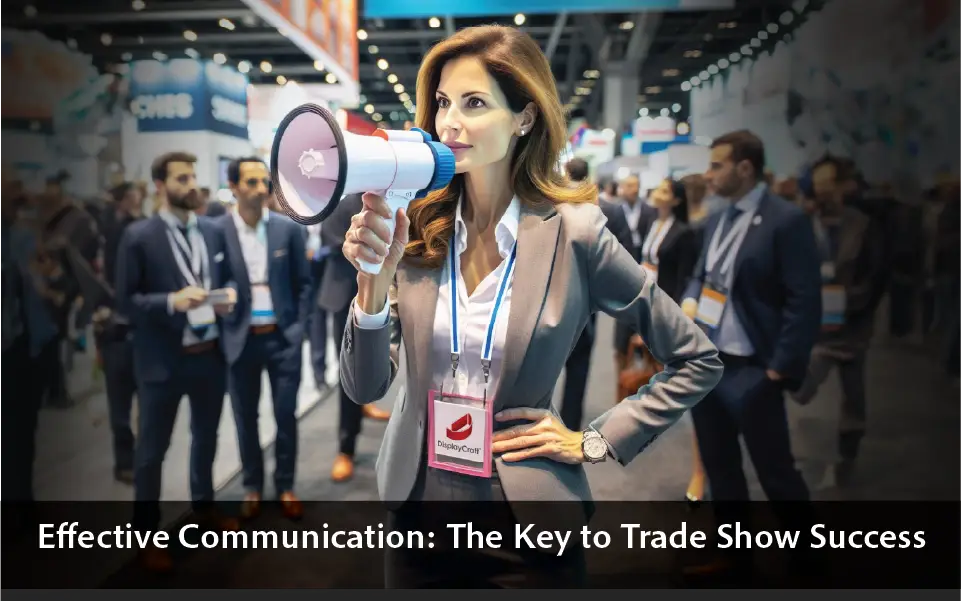Tips for Successful Exhibiting
A company’s trade show exhibit is a three-dimensional marketing vehicle and a vital part of an effective, integrated marketing mix. Since the chance to gain a potential customer’s attention passes quickly for a typical visitor (three seconds is all you get), the right trade show booth design, integrated with powerful messaging, is critical to successful exhibiting.
In addition, a company’s trade show return on investment depends on various factors. Exhibit architecture, pre-show promotional activities, exhibit staff and training, as well as lead generation and follow-up, all factor into overall event marketing effectiveness.
Trade show exhibits are utilized to introduce new products/services, introduce or reinforce your brand, announce market entrance and the list goes on. How can you get the very most out of your exhibit experience?
Here are some exhibiting tips for achieving a powerful blend of design and effective brand messaging:
- Design the booth so visitors can navigate easily without feeling crowded. Keep the atmosphere intimate, and remove any barriers between yourself and your audience.
- Develop a realistic show budget that allocates money where it is needed.
- Keep the message simple so as not to overload visitors with information.
- Have a clear goal, and make it specific. Don’t try to accomplish too much. Make your goals measurable in order to gauge the exhibit’s effectiveness after the show.
- Use signs and graphics to focus visitors’ attention on your message.
- Use product demonstrations for visitors to remember. Be sure they tie in with your product message.
- Address the needs of the target audience.
- Consider offering a giveaway or promotional product that conveys your message in a way that ties in with the exhibit’s theme.
- Think integrated marketing, consistent branding of your exhibit with promotional activities via website, print advertising, electronic outreach, etc.

Successful Exhibiting is Strategic as well as Logistic
The first step in planning your trade show success is setting effective and realistic objectives and means of measurement. Effectively planning your show’s objectives and reasons for exhibiting are critical. Asking why you are there and what the expected outcome should be is necessary for any successful exhibiting venture. Choosing the right measurement tools lets you draw the correct conclusion and evaluate your return on investment (ROI).
Setting objectives for each event ensures you align the short-term (tactics) with the long-range (strategies). When you include specific measurements for assessing the outcome of each show, you can:
Justify individual show participation and increase the effectiveness of your overall program.
Most exhibit professionals are relied upon as logistics experts who ensure that exhibit properties are ready, all messaging is targeted, and requisite show services are ordered within the deadline period.
Candidly speaking, too many exhibiting companies fail to do their homework about shows. They fail to set objectives, measure results, and follow up on leads.
Too many companies exhibit at shows for vague reasons, i.e., to show support for an industry or simply because their competition is there. They go because they’ve always done so, for many reasons not cemented in strategic marketing rationale.
Less than half of all companies that exhibit set out formalized and measurable goals. As the old adage says, “If you don’t know where you’re going, any road will get you there.”
In some cases, there is a significant communication disconnect between what senior management expects and what the exhibit manager understands the strategic purposes and goals relative to a particular show. Often, this disconnect is due to internal failure to communicate effectively what results are expected and what goals to strive for.
Many in the industry confuse and interchangeably use return on investment (ROI) and return on objective (ROO). ROI quantifies the financial return on your exhibiting investment compared to sales generated from the event. ROO analyzes the return generated from objectives where sales are not immediately closed, such as demonstrations, live presentations, customer meetings, and hospitalities.
We can measure objective and subjective show objectives, but we cannot generate ROI without sales from the event. According to the Center for Exhibition Industry Research (CEIR), 86 percent of exhibitors exhibit to generate new leads for sales, so let’s look at measuring those results:
- After generating qualified leads, insert them into your contact management program’s database.
- Categorize leads as “A”- Hot, “B” – Near Term, “C” – Longer Term, and maybe only information requests.
- Define the “good” leads and their sales potential with management to translate the leads portion of the equation as a base in forecasting potential sales resulting from the show.
- Create a closed-loop system for lead management and activity reports from the field.
- Create a report that tracks the leads for the first 90 and 180 days after the show closes.
- Use the experience of the last show as the benchmark for future events.
Imagine this: You’re standing proudly in your gorgeous new trade show exhibit, flanked by your boss at the opening of your major industry show. The first attendee approaches, staring at the beautiful edifice you helped create, only to ask, “So… what is it that you do?”
Ouch. To get your message across and avoid hearing that painful question, ask yourself these questions first:
- Do your exhibit graphics convey who you are, what you do, and your benefit to them?
- When you state those clearly, you’ll bring in more interest and more qualified visitors.
- Are you trying to say too much? Trade show attendees walking down the aisle only have time to look at images, not read paragraphs. Go for impact over information. Big, bold images and concise copy rule the show floor.
- Are the words on your exhibit legible? Look out for text that is too small, has a low contrast to its background, a type font so “creative” it can’t be read, or is hidden by other exhibit components.
- Are your graphics crisp? The digital graphic file that was sharp enough for your brochure may be too small to create high-resolution, large-format exhibit graphics.
- Does your exhibit look like it represents the same company as your other customer touchpoints, such as your website, direct mail, or magazine ads? Integrated branding is more memorable and effective than different looks in different media.
How Do Exhibitors Measure Trade Show Results?
The following categories illustrate how companies perceive the value of measurable results:
Note: The higher the percentage, the more important it’s perceived value.
- Sales from leads: 63%
- Sales leads: 60%
- Number of contacts: 43%
- Number of inquiries: 40%
- ROI: 33%
- Literature distributed: 16%
- Outside research: 4%
- Don’t measure: 2%
Please read our article for tips and strategies to measure and improve trade show ROI.
The Six Elements of Successful Trade Show Exhibit Design

Do you want to position yourself in the foremost part of the visitor’s mind so that they see no suitable substitute for you? That you are remembered and that you message has registered? Then follow the Six Elements to Successful Exhibit Design below.
The focus of successful design is always customer-centric. Capture the imagination.
- Attract attention
- Engage through architecture
- Convey powerful branding
- Evoke a feeling, stir a sensation
- Foster comfort and accessibility
- Create memorable impressions
Design the exhibit as a communication tool. What should the environment represent?
Visualize – What kind of image do you want to convey?
Define – What are you trying to accomplish?
Identity – Who is your target audience?
Optimize – How can you maximize your budget?
Pre-TradeShow Promotion
It is crucial to attract current and potential customers to your trade show exhibit. You should target your audience well in advance of the show. Invite them to see you there and experience all the latest your company has to offer. Indicate the benefits and features to expect upon visiting and establish a “hook” for added enticement. Add value for the recipient.
Most trade show visitors have a fairly set schedule at shows, so time is at a premium. Creating interesting pre-show promotional marketing pieces lets you touch visitors while informing them of your presence at the show and entices them to visit. It gets you on their schedule.
Raffles or other giveaways may also be incorporated into the promotion to enhance further the chances of your target audience visiting the exhibit.
Pre-show promotions and invitations should be delivered 4 to 6 weeks before the show, depending on circumstances. Studies show that pre-promotion can boost lead counts by 33% or more.
Lead Generation and Proper Follow Up
As the tale goes, two partners were exhibiting at their first show. Their strategy was simple, just take along a few samples of their products, talk to the attendees and collect business cards in a fishbowl placed on a table at the front of their booth.
The show drew a large crowd; business cards nearly filled the fishbowl. They went home feeling that they had completed their mission. They returned to work and contacted the people who had dropped off business cards. The problem became apparent immediately. There was no way, from business cards alone, to re-connect with the needs of the prospects without starting over at square one. The needs of each, as determined through prior conversation, was lost. The needs of each, as determined through prior conversation, was lost.
Most, but not all, trade show and events have electronic lead retrieval and data management programs available for the capture of visitor information. In those cases where it is not available, companies should devise a manual method of capturing visitor data.
Regardless of methodology, it is a certain truth in all shows that accurate information attained, coupled with knowledgeable and timely follow up will result in a greater return on investment.
One step in ensuring prompt and thorough lead follow up is to create a lead information card. This simple communication device will accomplish specific goals geared toward realizing a much more productive trade show program. Devote serious time and attention to what goes on the card. What data is essential to capture? The information generated must be complete, concise and actionable.
Here are a few ways a well thought-out lead card can add strength to your trade show program:
- Focus the content on gathering information relative to current marketing goals.
- Understand exactly who is to be contacted, by what date and by what method. Ensure the capture of all pertinent information necessary to do so.
- Provide a clear and actionable description of tasks to those who must provide follow-up (even if it’s you). You cannot accurately recall the dozens of contacts that come at you during the show.
- Script a standardized inquiry procedure for booth staff to follow.
- Measure results daily against pre-show goals.
- Assess booth staff performance with objective, quantified data.
After each show, evaluate what worked and what needs improvement relative to information acquisition.
Be sure to review the requested criteria periodically to be sure that it stays relevant to your exhibiting mission and goals. Finally, always provide a means to quickly and efficiently distribute all leads to those in charge of follow-up.
Regardless of whether you are using an electronic lead management system, your own lead form for capturing specific information can be advantageous. When you create the form, get your sales organization (who will be using it) to review it prior to giving it to them to use at the show. Get early buy-in.
Train your staff how to capture information in the interview process. What information should they be seeking that will be beneficial to informed follow-up?
Coach your staff to categorize your leads “A”, “B”, “C” as they are generated, and review them each night for completeness. Establish a hierarchy for lead importance.
Create a system to manage the leads. When the show ends (or possibly at each day’s end) how are leads fulfilled, who (or what team) is responsible for the follow up and sustained pursuit?
Exhibit Staffing and Training
There are many obvious “Don’ts” when staffing an exhibit (“don’t drink, don’t smoke, don’t eat”). There are also attitude and etiquette behaviors that may seem self-evident but often are not. While you may already be following some of these suggestions, it’s common to find violators at every turn.
- Successful exhibiting is a TEAM event. Rely on others and work in cohesion.
- Wear your badge on the right hand side so it can be seen by your visitor when shaking hands.
- Smile. 90% of the time if you smile then someone will smile back at you.
- Prepare and practice questions that won’t elicit a “yes” or “no” answer.
- If you don’t know the answer to a question, say so and use it as an excuse to follow up after the show with the answer when you locate it.
- Make only those commitments that you and others can keep. Visitors remember staffer commitments, especially those that are not kept.
- Visit with prospects only. A crowd of staffers does not attract a crowd of visitors.
- The exhibit is your office away from the office. As visitors see your environment, they also see your company.
- Maintain a clean and orderly space while making it inviting.
Reinforcing the Obvious
It is critical for your staff to create an inviting atmosphere while making it appealing for attendees to stop and enter your exhibit. What you don’t do can be as important as what you actually do. The following are things to avoid:
- Don’t Sit. You give attendees the impression you’re indifferent.
- Don’t Read. You’re not making eye contact with attendees.
- Don’t Eat or Drink. It is just another obvious, yet common, occurrence.
- Don’t Ignore Attendees. If you’re busy when someone approaches, acknowledge them or try to include them in your conversation.
- Don’t Talk on Your Cell. If you have to make or receive a call, it’s best to do so privately.
- Don’t Be a Border Guard. Stand near the aisle and off to one side rather than where you become a barricade or block the attendees’ view.
- Don’t Hand Out Literature Freely. Be discriminating with literature distribution. Consider mailing to qualified prospects after the show.
- Don’t Underestimate Prospects. Avoid the temptation of sizing up somebody simply by the way they look. Qualify them but don’t classify them.
- Don’t Cluster With Other Booth Personnel. Few will approach a group of strangers because it’s often too intimidating. Be more approachable.
Engage
Before going to a trade show, your exhibit team should brainstorm possible questions. Construct three or four open-ended questions and practice them. Then after your show, while things are still fresh, evaluate and tweak your questions towards perfection.
Time parameters to consider:
- Engage: 30 seconds
- Qualify: 2 minutes
- Determine if the prospect requires presenting to … and what to present.
- Present: 5-10 minutes
- Close: 2 minutes
Prepare for common questions and objections.
Present to the prospect’s needs, not necessarily everything your company does.
Visitor information captured? Recap the next steps and go on to the next lead!
“Can I help you?” While it may seem perfectly natural to ask that of trade show attendees walking by your exhibit – it’s a question you need to avoid. Why? Because it’s close-ended and attendees can end the conversation simply by saying “no.”
The best way to find out about a prospect’s interests is by asking open-ended questions that encourage them to reveal more about themselves than a simple “yes” or “no.” Open-ended questions begin with words like “Tell me, What, When, Where, How, Describe, Who.”
- Tell me more about your business.
- What about our exhibit caught your eye?
- What kind of business are you in?
- Who are your clients?
- How are your current needs not being met?






